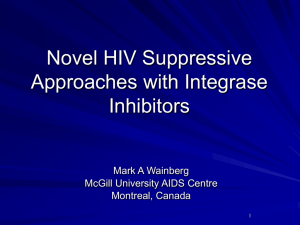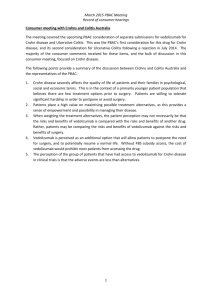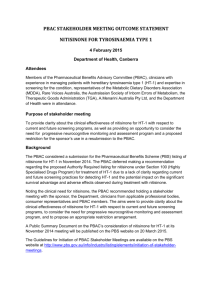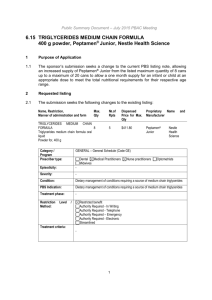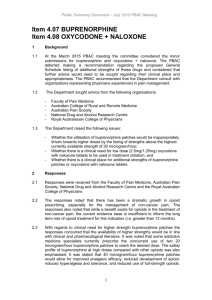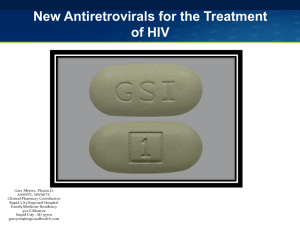(PSD) November 2014 PBAC Meeting
advertisement
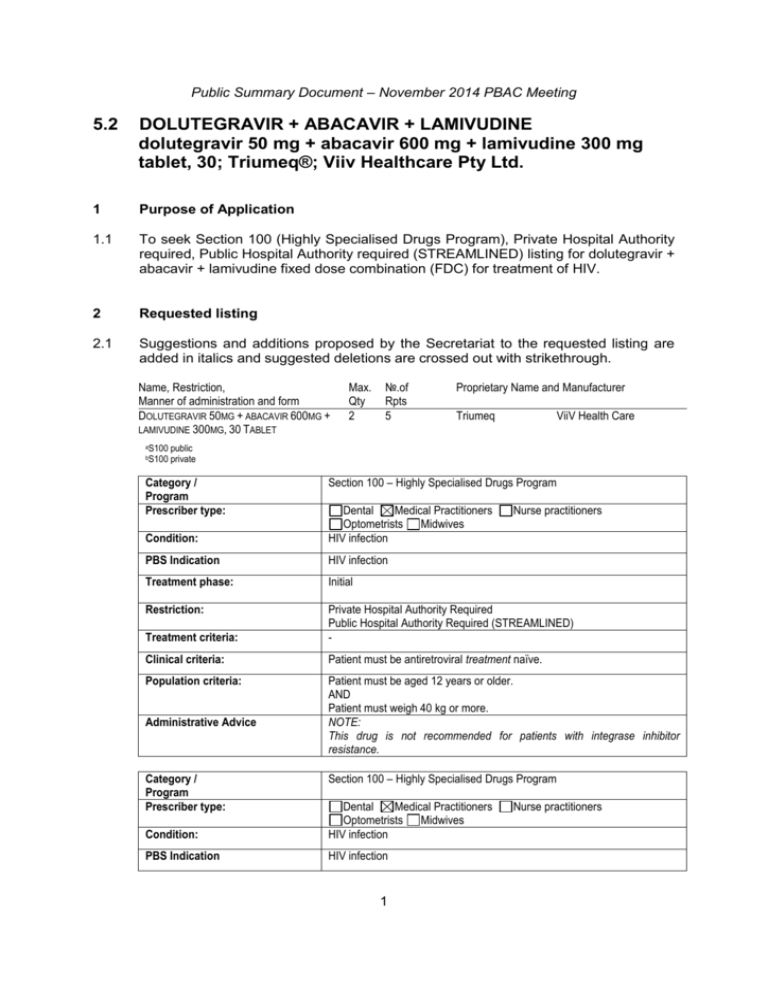
Public Summary Document – November 2014 PBAC Meeting 5.2 DOLUTEGRAVIR + ABACAVIR + LAMIVUDINE dolutegravir 50 mg + abacavir 600 mg + lamivudine 300 mg tablet, 30; Triumeq®; Viiv Healthcare Pty Ltd. 1 Purpose of Application 1.1 To seek Section 100 (Highly Specialised Drugs Program), Private Hospital Authority required, Public Hospital Authority required (STREAMLINED) listing for dolutegravir + abacavir + lamivudine fixed dose combination (FDC) for treatment of HIV. 2 Requested listing 2.1 Suggestions and additions proposed by the Secretariat to the requested listing are added in italics and suggested deletions are crossed out with strikethrough. Name, Restriction, Manner of administration and form DOLUTEGRAVIR 50MG + ABACAVIR 600MG + LAMIVUDINE 300MG, 30 TABLET aS100 bS100 Max. Qty 2 №.of Rpts 5 Proprietary Name and Manufacturer Triumeq ViiV Health Care public private Category / Program Prescriber type: Section 100 – Highly Specialised Drugs Program Condition: Dental Medical Practitioners Optometrists Midwives HIV infection PBS Indication HIV infection Treatment phase: Initial Restriction: Treatment criteria: Private Hospital Authority Required Public Hospital Authority Required (STREAMLINED) - Clinical criteria: Patient must be antiretroviral treatment naïve. Population criteria: Patient must be aged 12 years or older. AND Patient must weigh 40 kg or more. NOTE: This drug is not recommended for patients with integrase inhibitor resistance. Administrative Advice Category / Program Prescriber type: Nurse practitioners Section 100 – Highly Specialised Drugs Program Condition: Dental Medical Practitioners Optometrists Midwives HIV infection PBS Indication HIV infection 1 Nurse practitioners Public Summary Document – November 2014 PBAC Meeting Treatment phase: Continuing Restriction: Private Hospital Authority Required Public Hospital Authority Required (STREAMLINED) Patient must have previously received PBS-subsidised therapy for HIV infection. Patient must be aged 12 years or older AND Patient must weigh 40 kg or more. NOTE: This drug is not recommended for patients with integrase inhibitor resistance. Clinical criteria: Population criteria: Administrative Advice 2.2 The requested listing was based on a cost-minimisation analysis versus dolutegravir and Kivexa (abacavir + lamivudine FDC) taken concomitantly. 2.3 The submission stated that patients who carry the HLA-B*5701 allele are at high risk for experiencing a hypersensitivity reaction to abacavir. The estimated prevalence of the allele is 5.6% (Mallal et al 2008). Patients are screened for HLA-B*5701 prior to initiating therapy with abacavir or abacavir containing therapy such as Kivexa or Triumeq. The screening for HLA-B*5701 is currently funded on the MBS (Items 71203 or 73323) but the submission does not expect an increase in HLA-B*5701 screening or any additional cost to the MBS. While the submission assumes that a significant number of patients will switch from dolutegravir + Truvada (emtricitabine + tenofovir) and will need to be screened for HLA-B*5701 before initiating therapy on Triumeq, the Pre-Sub-Committee Response (PSCR) argued that it is current practice to screen all newly diagnosed HIV patients for the allele (HIV Management in Australia: A guide for clinical care, p74). The ESC agreed that it is current practice to screen all newly diagnosed patients for the hypersensitivity reaction to abacavir, regardless of whether they are initially treated with an abacavir-containing therapy. For more detail on PBAC’s view, see section 7 “PBAC outcome” 3 Background 3.1 TGA status at time of PBAC consideration: Not registered. The submission was made under TGA/PBAC Parallel Process. At the time of PBAC consideration, a positive TGA Delegate summary was available. 3.2 Dolutegravir + abacavir + lamivudine FDC had not previously been considered by the PBAC. For more detail on PBAC’s view, see section 7 “PBAC outcome” 4 Clinical place for the proposed therapy 4.1 HIV infection can lead to the destruction of the patient’s natural immune system. The recommended treatment for HIV therapy is to use at least three different agents, with 2 to 3 being fully active or likely to be fully active. This applies for initiating as well as second, third and fourth line treatment. 2 Public Summary Document – November 2014 PBAC Meeting 4.2 Dolutegravir + abacavir + lamivudine FDC can be used in any line of therapy. For more detail on PBAC’s view, see section 7 “PBAC outcome” 5 Comparator 5.1 The submission nominated dolutegravir + Kivexa which the ESC agreed is an appropriate comparator. 5.2 The ESC also recommended PBAC consider whether the nominated comparator of dolutegravir and Kivexa is more appropriate than the other triple FDCs recommended as first-line therapy for HIV. The submission nominated Atripla (tenofovir + emtricitabine + efavirenz) as a secondary comparator. For more detail on PBAC’s view, see section 7 “PBAC outcome” 6 Consideration of the evidence Sponsor hearing 6.1 There was no hearing for this item. Consumer comments 6.2 The PBAC noted that no consumer comments were received in the submission. Clinical trials 6.3 The submission was based on one head-to-head pharmacokinetic trial comparing the Triumeq FDC to dolutegravir + Kivexa (n=66). Clinical trials comparing dolutegravir + Kivexa with other HIV therapies were also included as supporting evidence. 6.4 Details of the trials presented in the submission are provided in the following table. 3 Public Summary Document – November 2014 PBAC Meeting Trials and associated reports presented in the submission Trial ID Protocol title/ Publication title Publication citation Direct randomised trial – Triumeq versus dolutegravir + Kivexa ING114580 An Evaluation of the Bioequivalence of a Combined Formulated Tablet 13 June 2013 (50mg/600mg/300mg dolutegravir/abacavir/lamivudine) Compared to One Dolutegravir 50mg Tablet and One EPZICOM (600mg/300mg abacavir/lamivudine) Tablet Administered Concurrently and the Effect of Food on Bioavailability of the Combined Formulation in Healthy Adult Subjects. Supplementary randomised trials SPRING-2 A Phase III, randomized, double blind study of the safety and efficacy of 10 May 2013. GSK1349572 50mg once daily compared to raltegravir 400mg twice daily both administered with fixed-dose dual nucleoside reverse transcriptase inhibitor therapy over 96 weeks in HIV-1 infected antiretroviral naive adult patients. 96 week results. 10 May 2013. Publication of 48 week results: Raffi, F., Rachlis, A., Stellbrink, H. J., Hardy, W. The Lancet, 381 D., Torti, C., Orkin, C., Bloch, M., Podzamczer, D., Pokrovsky, V., Pulido, F., (9868) pp.735-743. Almond, S., Margolis, D., Brennan, C., and Min, S. (2013), 'Once-daily dolutegravir versus raltegravir in antiretroviral-naive adults with HIV-1 infection: 48 week results from the randomised, double-blind, non-inferiority SPRING-2 study', SINGLE Publication of 96 week results: Raffi, François, et al. "Once-daily dolutegravir versus twice-daily raltegravir in antiretroviral-naive adults with HIV-1 infection (SPRING-2 study): 96 week results from a randomised, double-blind, noninferiority trial." The Lancet infectious diseases 13.11 (2013): 927-935. A Phase III, randomized, double-blind study of the safety and efficacy of GSK1349572 plus abacavir-lamivudine fixed-dose combination therapy administered once daily compared to Atripla over 96 weeks in HIV-1 infected antiretroviral therapy naive adult subjects. 20 August 2013. Publication of 48 week results: Walmsley, S. L., Antela, A., Clumeck, N., Duiculescu, D., Eberhard, A., Gutiérrez, F., & Nichols, G. (2013). Dolutegravir plus Abacavir–Lamivudine for the Treatment of HIV-1 Infection. New England Journal of Medicine, 369(19), 1807-1818. FLAMINGO A Phase IIIb, randomized, open-label study of the safety and efficacy of GSK1349572 (dolutegravir, DTG) 50 mg once daily compared to darunavir/ritonavir (DRV/r) 800 mg/100 mg once daily each administered with fixed-dose dual nucleoside reverse transcriptase inhibitor therapy over 96 weeks in HIV-1 infected antiretroviral naïve adult subjects. 48 week results, 23 July 2013. Source: Table B.4, p37 of the submission 6.5 The key features of the direct randomised trials are summarised in the following table. 4 Public Summary Document – November 2014 PBAC Meeting Key features of the included evidence Design / Risk of Patient Trial N duration bias population Cross-overa, Healthy ING114580 66 Low OL subjects SPRING-2 822 RCT, DB Low Treatment naïve HIV SINGLE 833 RCT, DB Low Treatment naïve HIV FLAMINGO 484 RCT, OL Low HIV Outcomes / duration Triumeq Pharmacokinetic 24 hours Dolutegravir + Kivexa HIV <50 Dolutegravir + Kivexa/Truvada copies/mL at 48, Raltegravir + Kivexa/Truvada 96 weeks HIV <50 Dolutegravir + Kivexa copies/mL at 48, Atripla 96 weeks Dolutegravir + Kivexa/Truvada HIV <50 copies/mL at 48 Darunavir + Ritonavir + weeks Kivexa/Truvada Therapies compared Used in model Yes – cost-min No No No DB=double blind; MC=multi-centre; OL=open label Truvada = emtricitabine 200mg + tenofovir 300mg FDC; Atripla = emtricitabine 200mg + tenofovir 300mg + efavirenz 600mg FDC a Randomised to one of two treatment sequences: patients in sequence 1 received a single dose of Triumeq orally, then after a wash out of at least 7 days, received a single dose of dolutegravir + Kivexa; patients in sequence 2 were treated in the opposite manner, with dolutegravir + Kivexa first then Triumeq after washout. Source: compiled during the evaluation Comparative effectiveness 6.6 The ratio of geometric least square means for all pharmacokinetic parameters for all three drugs in the FDC fall within the pre-specified range of 80.00% and 125.00% compared with dolutegravir taken concomitantly with Kivexa and is presented below. Results of Trial ING114580 GLS Mean Triumeq FDC N=62 Ratio of GLS Means [90% CI] DTG+Kivexa N=62 Triumeq FDC vs DTG+Kivexa Dolutegravir AUC(0-∞) (µg.h/mL) 44.73 47.36 0.945 [0.889, 1.00] AUC(0-t) (µg.h/mL) 40.86 43.34 0.943 [0.888, 1.00] Cmax (µg/mL) 2.44 2.54 0.961 [0.906, 1.02] Abacavir AUC(0-∞) (µg.h/mL) 13.92 14.51 0.960 [0.939, 0.980] AUC(0-t) (µg.h/mL) 13.90 14.48 0.960 [0.939, 0.980] Cmax (µg/mL) 4.03 4.38 0.920 [0.867, 0.977] Lamivudine AUC(0-∞) (µg.h/mL) 12.75 13.12 0.972 [0.940, 1.01] AUC(0-t) (µg.h/mL) 12.30 12.81 0.960 [0.928, 0.994] Cmax (µg/mL) 2.11 2.28 0.926 [0.885, 0.968] Abbreviations: AUC: Area Under the Curve; DTG: dolutegravir; GLS: Geometric least squares Source: Table B.17, p63 of the submission 6.7 The comparisons of dolutegravir + Kivexa versus raltegravir + Kivexa and versus darunavir + ritonavir + Kivexa indicated no statistically significant differences in the proportion of patients achieving a viral load of <50 copies/mL and is presented in the following table. A comparison of dolutegravir + Kivexa versus Atripla indicated a statistically significantly greater proportion of patients treated with dolutegravir + Kivexa achieved a viral load of <50 copies/mL (RD=7.3%, [95% CI: 2.3, 12.2] at 5 Public Summary Document – November 2014 PBAC Meeting 48 weeks and RD=7.9% [95% CI: 2.1, 13.6] at 96 weeks). However, given the growing number of options for treatment in the setting of virological failure, the clinical significance of this difference is not established in the submission. Results of proportion of patients with HIV RNA level of less than 50 copies/mL at 48 and 96 weeks across the direct randomised trials in the subgroup of patients treated in combination with Kivexa only Dolutegravir 50mg Raltegravir Atripla OD Darunavir 800mg OD + Kivexa OD 400mg BD + OD+ Ritonavir Risk difference, Trial Kivexa OD 100mg OD + % Kivexa OD (95% CI) n/N (%) n/N (%) n/N (%) n/N (%) At 48 weeks SPRING-2 145/169 (86) 142/164 (87) NA NA -0.8 (-8.2, 6.6) SINGLE 364/414 (88) NA 338/419 (81) NA 7.3 (2.3, 12.2) FLAMINGO '''''''''''''' '''''''''' ''''''' '''''''' ''''''''''''''' ''''''''' '''''''' '''''''''''''' ''''''''''''' At 96 weeks SPRING-2 125/169 (74) 124/164 (76) NA NA -1.6 (-11.0, 7.7) SINGLE 332/414 (80) NA 303/419 (72) NA 7.9 (2.1,13.6) Abbreviations: OD = Once daily; BD = Twice daily Text in bold indicates statistically significant difference. Source: Table B.26, p72, Table B.27, p72, Table B.50, p97 of the submission 6.8 The PSCR argued that it is not appropriate to consider the difference between treatment groups in terms of a clinically relevant magnitude of improvement as the proportion of patients achieving virologic control (i.e. HIV-1 RNA <50 copies/mL) between treatment is a binary outcome. All patients that achieve virologic control derive clinical benefit. Across a cohort of treatment naive patients, a decision to use Triumeq in place of Atripla would result in an increase in the number of patients that achieve virological control and derive clinical benefit. The ESC considered that the data suggested that dolutegravir + Kivexa is statistically superior to Atripla for the proportion of patients achieving a viral load of <50 copies/mL at 48 and 96 weeks, however clinical superiority for Triumeq FDC over Atripla FDC is not demonstrated from the evidence from SINGLE. 6.9 The ESC noted there is evidence from SPRING-2 which indicates that patients treated with dolutegravir + Truvada (86% with HIV-1 RNA <50c/mL) may have better outcomes at 96 weeks compared to patients treated with dolutegravir + Kivexa (74% with HIV-1 RNA <50c/mL). This consideration is important as any cost savings assumed by the submission are completely dependent on the extent of substitution from patients using dolutegravir + Truvada to Triumeq. The PSCR argued that SPRING-2 was designed to demonstrate the non-inferiority of a dolutegravir containing regimen compared with a raltegravir containing regimen (each with two nucleoside reverse transcriptase inhibitors) and that it was not powered for formal statistical analyses of the stratification subgroup factors (i.e. nucleoside reverse transcriptase inhibitors and viral load). Comparative harms 6.10 The table below summarises the common adverse events in the four clinical trials presented in the submission. No difference in the safety profile of Triumeq compared to dolutegravir + Kivexa is expected or observed. 6 Public Summary Document – November 2014 PBAC Meeting Comparison of common adverse events in dolutegravir/abacavir/lamivudine treated patients across all trials ING114580 Dolutegravir + Kivexa/Truvada (Triumeq FDC) (DTG+Kivexa) SPRING-2 SINGLE FLAMINGO Adverse event N=65 N=65 N=411 N=414 N=242 n (%) n (%) n (%) n (%) n (%) Diarrhoea NR NR 57 (14) 84 (20) 41 (17) Nausea 11 (17) 19 (29) 60 (15) 65 (16) 39 (16) Headache 4 (6) 5 (8) 56 (14) 63 (15) 37 (15) Nasopharyngitis NR NR 55 (13) 74 (18) 22 (9) Somnolence 5 (8) 2 (3) NR 9 (2) NR Source: Table B.58, p108 of the submission 6.11 The evaluation stated that although statistically fewer patients treated with dolutegravir + Kivexa withdrew from treatment compared with Atripla, the rate of withdrawal appears unrelated to the overall adverse event rate for some reported adverse events. The ESC disagreed with the evaluation and considered this is significant and indicative of the apparent favourable side-effects profile of dolutegravir + Kivexa compared with Atripla. Benefits/harms 6.12 No clinical evidence comparing Triumeq with dolutegravir + Kivexa has been presented. Clinical trials comparing dolutegravir + Kivexa versus other HIV antiretroviral therapies indicate comparable efficacy and safety. 6.13 No information regarding the comparative benefits and harms for Triumeq versus dolutegravir + Kivexa is available. However, the pharmacokinetic profiles appear comparable and no difference in the safety profile of Triumeq compared to dolutegravir + Kivexa is expected or observed. 6.14 On the basis of direct pharmacokinetic trial evidence presented by the submission, no differences in the efficacy and safety between Triumeq and dolutegravir + Kivexa are assumed. 6.15 The ESC noted that if the PBAC viewed that Triumeq should be compared against Atripla, the following comparative benefits and harms (provided in the following table) should be considered. 7 Public Summary Document – November 2014 PBAC Meeting Summary of comparative benefits and harms for dolutegravir + Kivexa and Atripla Event rate/100 patients* Dolutegravir Dolutegravir 50mg OD + Atripla RR Trial 50mg OD + Atripla Kivexa OD n/N (95% CI) Kivexa OD n/N Benefits Proportion of patients with HIV RNA level of less than 50 copies/mL at 48 weeks SINGLE 364/414 338/419 1.09 (1.03, 1.16) 88 81 Proportion of patients with HIV RNA level of less than 50 copies/mL at 96 weeks SINGLE 332/414 303/419 1.11 (1.03, 1.20) 80 72 Harms^ Event rate/100 patients* Adverse Dolutegravir Dolutegravir events 50mg OD + Atripla RR 50mg OD + Atripla reported in Kivexa OD n/N (95% CI) Kivexa OD SINGLE n/N Abnormal dreams Insomnia Dizziness Somnolence Rash Influenza Pain in extremity RD (95% CI) 7.3 (2.3, 12.2) 7.9 (2.1, 13.6) RD (95% CI) 31/414 73/419 0.43 (0.29, 0.64) 7 17 -10 (-13, -7) 69/414 40/414 9/414 19/414 ''''''''''''''' 46/419 153/419 24/419 60/419 ''''''''''''''''' 1.52 (1.07, 2.15) 0.26 (0.19, 0.36) 0.38 (0.18, 0.81) 0.32 (0.19, 0.53) '''''''''' ''''''''''''''''''''''''' 17 10 2 5 '''' 11 37 6 14 '''' 6 (2, 9) -27 (-30, -24) -4 (-5, -2) -10 (-12, -8) '''' ''''''' ''''' '''''''''''''''' ''''''''''''''' '''''''''' ''''''''''''''''''''''''''' '''' ''' ''' '''''' '''''' * Mean (SD) duration of treatment in SINGLE: 606.3 (170.63 days) for dolutegravir + Kivexa, 554.4 (221.46) days for Atripla ^Only statistically significant differences are shown. Abbreviations: RD = risk difference; RR = risk ratio Source: Compiled during the evaluation 6.16 On the basis of direct evidence presented by the submission, for every 100 patients treated with dolutegravir plus Kivexa in comparison to Atripla: Approximately 7 additional patients would have HIV RNA level less than 50 copies/mL over a maximum duration of follow-up of 48 weeks. Approximately 10 fewer patients would have abnormal dreams over a maximum duration of follow-up of 96 weeks. Approximately 6 additional patients would have insomnia over a maximum duration of follow-up of 96 weeks. Approximately 27 fewer patients would have dizziness over a maximum duration of follow-up of 96 weeks. Approximately 4 fewer patients would have somnolence over a maximum duration of follow-up of 96 weeks. Approximately 9 fewer patients would have rash over a maximum duration of follow-up of 96 weeks. Approximately 3 additional patients would have influenza over a maximum duration of follow-up of 96 weeks. Approximately 3 additional patients would have pain in extremity over a maximum duration of follow-up of 96 weeks. Clinical claim 8 Public Summary Document – November 2014 PBAC Meeting 6.17 The submission describes the Triumeq FDC as bioequivalent to dolutegravir 50mg + Kivexa. The ESC agreed this may be reasonable, subject to advice from the TGA. For detail on PBAC’s view, see section 7 “PBAC outcome” Economic analysis 6.18 The submission presents a cost-minimisation analysis based on 1 Triumeq tablet = 1 dolutegravir 50mg tablet + 1 Kivexa tablet, presented below. Cost-minimisation analysis of Triumeq to dolutegravir plus Kivexa Product S100 (Public) Dolutegravir Kivexa Triumeq S100 (Private) Dolutegravir PBS Code Max Qty Strength 10065R Pack size DPMQ 50mg 60 30 '''''''''''''''''''''' Abacavir 300mg 5603x 60 30 ''''''''''''''''''''' Lamivudine 300mg Dolutegravir 50mg NA Abacavir 300mg 60 30 '''''''''''''''''''''''' Lamivudine 300mg Incremental cost (Triumeq – dolutegravir + Kivexa) ''''''' Cost per daily dose (1 tab dolutegravir + 1 tab Kivexa OR 1 tab Triumeq) '''''''''''''''''' ''''''''''''''' '''''''''''''''' '''''' 50mg 60 30 ''''''''''''''''''''''' ''''''''''''''''' Abacavir300mg Kivexa 6458X 60 30 '''''''''''''''''' '''' ''''''''''''''' Lamivudine 300mg Dolutegravir 50mg Triumeq NA Abacavir 300mg 60 30 ''''''''''''''''''''''''' ''''''''''''''''' Lamivudine 300mg Incremental cost (Triumeq – dolutegravir + Kivexa) '''''''''''''''' '''''''''''''' a Dolutegravir DPMQ listed as ''''''''''''''''''''''' in submission but is $1,377.86 in PBS schedule b Price for Kivexa is lower than currently listed on PBS schedule as lamivudine will be subject to a price reduction from 1 October 2014. The price of Kivexa was adjusted to reflect the upcoming price reduction. Source: Table D.2 and D.3, p157 of the submission 6.19 10070B The price proposed for the Triumeq is higher than the current PBS price for Atripla ($2,073.36 DPMQ), and other similar PBS listed combination antiviral drugs (see table below for comparative approved ex-manufacturer prices). 9 Public Summary Document – November 2014 PBAC Meeting Ex-manufacturer prices for triple and quadruple combination antivirals Drug Form Brand Pack Quantity Currently PBS listed triple and quadruple combinations Tenofovir with Tablet containing tenofovir Atripla emtricitabine and disoproxil fumarate 300 mg with efavirenz emtricitabine 200 mg and efavirenz 600 mg Tenofovir with Tablet containing tenofovir Eviplera emtricitabine and disoproxil fumarate 300 mg with rilpivirine emtricitabine 200 mg and rilpivirine 25 mg (as hydrochloride) Tenofovir with Tablet containing tenofovir Stribild emtricitabine, disoproxil fumarate 300 mg with elvitegravir and emtricitabine 200 mg, elvitegravir cobicistat 150 mg and cobicistat 150 mg Proposed listing Dolutegravir with Tablet containing dolutegravir Triumeq abacavir and 50mg with abacavir 600mg and lamivudine lamivudine 300mg Source: http://www.pbs.gov.au/info/industry/pricing/ex-manufacturer-price. Approved Ex-Manufacturer Price 30 $1,036.68 30 $1,036.68 30 $1,036.68 30 '''''''''''''''''''' Drug cost/patient/year 6.20 Assuming 6.09 scripts/year for Triumeq and its nominated comparators of dolutegravir + Kivexa and Atripla, drug costs/patient/year are summarised below. Drug cost/patient/year for Triumeq, dolutegravir + Kivexa and Atripla S100 Public Triumeq '''''''''''''''''''''''''' Dolutegravir + Kivexa $13,408.84 Atripla $12,626.76 6.21 S100 Private ''''''''''''''''''''''' $13,946.10 $12,911.53 The ESC noted that the submission assumed relatively more patients substituting Triumeq for dolutegravir + Truvada than for cheaper single tablet FDCs including Atripla. The absolute and relative substitution of Triumeq for other combinations is speculative and has financial implications because of the difference in costs associated with alternative combination regimens. Estimated PBS usage & financial implications 6.22 The submission presented a mixed epidemiological and market share approach to estimate the utilisation and financial impact of Triumeq if listed on the PBS. 6.23 The submission anticipated the listing of Triumeq to impact on two areas of the HIV treatment market: the use of integrase inhibitors (dolutegravir and raltegravir) plus a dual NRTI FDC (Kivexa and Truvada), and the use of alternative single tablet regimens (Atripla, Eviplera, Stribild). 6.24 The submission’s predicted number of patients treated with, and costs for Triumeq, and the net cost offsets to the PBS for substitution of alternative therapies (Atripla, 10 Public Summary Document – November 2014 PBAC Meeting INI plus Kivexa and INI plus Truvada) are provided in the two following tables. Estimated cost for Triumeq 2015 Total number of patients '''''''' Number of packs ''''''''''''''' Total cost of Triumeq to PBS/RPBS '''''''''''''''''''''''''''' Copayments '''''''''''''''''''''' Net cost to PBS/RPBS ''''''''''''''''''''''''''''' Source: Commentary Table E.2.1 2016 '''''''''''''' '''''''''''' ''''''''''''''''''''''''''''' '''''''''''''''''''' ''''''''''''''''''''''''''''' 2017 '''''''''''''' '''''''''''''''' ''''''''''''''''''''''''''''' '''''''''''''''''''' ''''''''''''''''''''''''''' 2018 ''''''''''''' ''''''''''''''' ''''''''''''''''''''''''''' ''''''''''''''''''''''' '''''''''''''''''''''''''''''' 2019 ''''''''''''''' ''''''''''''''' '''''''''''''''''''''''''''''' ''''''''''''''''''''' ''''''''''''''''''''''''''' The redacted table shows: Estimated patient numbers to be less than 10,000 per year; Estimated net cost to the PBS/RPBS for Triumeq to be less than $10 million per year in year 1 increasing to $30-$60 million per year in year 5. Cost offset for substituted drugs 2015 2016 2017 2018 2019 Switching from Atripla (and other single table regimens) Total number of patients ''''''''' '''''''''' ''''''''' ''''''''' ''''''''''''''' Number of packs '''''''''''' '''''''''' ''''''''''' ''''''''''''' ''''''''''' Total cost of Triumeq to PBS/RPBS ''''''''''''''''''''''''' '''''''''''''''''''''''''''' '''''''''''''''''''''''' ''''''''''''''''''''''''''''''' '''''''''''''''''''''''''''' Copayments ''''''''''''''''''' ''''''''''''''''''''' ''''''''''''''''''''' '''''''''''''''''''''''' '''''''''''''''''''''' Net cost to PBS/RPBS ''''''''''''''''''''''' ''''''''''''''''''''''''' '''''''''''''''''''''''''''' ''''''''''''''''''''''''''''' ''''''''''''''''''''''''''''' Switching from INI plus Kivexa Total number of patients '''''''''' '''''''''' ''''''''' '''''''''' ''''''''' Number of packs ''''''''''' ''''''''''''' '''''''''''' '''''''''''' ''''''''''' Total cost of Triumeq to PBS/RPBS ''''''''''''''''''''''''''' ''''''''''''''''''''''''' '''''''''''''''''''''''''''' ''''''''''''''''''''''''''''' ''''''''''''''''''''''''''''' Copayments ''''''''''''''''''' '''''''''''''''''''''' '''''''''''''''''''' ''''''''''''''''''''''' '''''''''''''''''''' Net cost to PBS/RPBS ''''''''''''''''''''''''''' ''''''''''''''''''''''''' '''''''''''''''''''''''''''' ''''''''''''''''''''''''' ''''''''''''''''''''''''''''''' Switching from INI plus Truvada Total number of patients '''''''''' '''''''''' ''''''''' ''''''''''''''' '''''''''''' Number of packs '''''''''''' ''''''''''' '''''''''' ''''''''''' ''''''''''''' Total cost of Triumeq to PBS/RPBS ''''''''''''''''''''''''' '''''''''''''''''''''''''''''''' ''''''''''''''''''''''''''' '''''''''''''''''''''''''''''' '''''''''''''''''''''''''''' Copayments ''''''''''''''''''''''' ''''''''''''''''''''''' ''''''''''''''''''''' '''''''''''''''''''''' '''''''''''''''''''' Net cost to PBS/RPBS ''''''''''''''''''''''''''' '''''''''''''''''''''''''''' ''''''''''''''''''''''''''''' '''''''''''''''''''''''''''' ''''''''''''''''''''''''''''' Total cost offsets ''''''''''''''''''''''''''' '''''''''''''''''''''''''''''' ''''''''''''''''''''''''''' ''''''''''''''''''''''''''''' '''''''''''''''''''''''''''''''' Source: Commentary Table E.3.1. Text in italics indicate values calculated during the evaluation. INI = Integrase Inhibitor 6.25 The table below summarises the net financial implication for the PBS/RPBS from the submission. Estimated financial impact on the PBS/RPBS of listing Triumeq 2015 2016 2017 2018 2019 Net cost of listing Triumeq '''''''''''''''''''''''''' ''''''''''''''''''''''''''''''''' ''''''''''''''''''''''''''' ''''''''''''''''''''''''''''''' '''''''''''''''''''''''''''''''' Cost offsets for substituted ''''''''''''''''''''''''''''' ''''''''''''''''''''''''''''''' '''''''''''''''''''''''''''''''' ''''''''''''''''''''''''''''' ''''''''''''''''''''''''''''''' drugs Difference '''''''''''''''''''''''''' ''''''''''''''''''''''''''''' ''''''''''''''''''''''''''' '''''''''''''''''''''''''''' ''''''''''''''''''''''''''''''' Source: Commentary Table E.3.1 11 Public Summary Document – November 2014 PBAC Meeting The redacted table shows the estimated financial impact on the PBS/RPBS to be a saving of less than $10 million per year. 6.26 In summary, DUSC considered the utilisation estimates presented in the submission to be underestimated and cost savings overestimated based on the following issues: The extent of substitution of Truvada + an integrase inhibitor (INI) drives the projected cost saving. DUSC considers the rate of substitution of Truvada + INI is overestimated in the submission given that Truvada is the NRTI backbone of currently available single tablet regimens. This is not the case for Kivexa patients. A number of data sources used in Section E could not be verified and appear to be based on US estimates. It is unclear how transferrable these estimates are to the Australian context. The underlying assumption of no likely growth in the market may not be reasonable given Triumeq offers a different NRTI backbone and this may meet an unmet clinical need for those patients that are not suitable for the current single tablet regimens. 6.27 The DUSC considered that revised estimates should remove the proportion delaying treatment by one year (small impact), amend the error in proportion of patients on INI + dual NRTI switching from '''''''''' to '''''''''''' (small impact), assume a base case estimate of Triumeq uptake in ''''''''''' rather than '''''''''''' of patients taking INI + Truvada (large impact), delete the annual Triumeq cessation from Year 1 (small impact), and remove discontinuations from the treatment experienced patients (small impact). The DUSC noted that based on the price of Triumeq proposed in the submission, these changes result in a net cost to the PBS over 5 years rather than a saving. For more detail on PBAC’s view, see section 7 “PBAC outcome” Request under subsection 101(4AC) of the National Health Act 1953 (‘the Act’) 6.28 The submission requested the PBAC provide advice to the Minister under subsection 101(4AC) of the Act. The submission also noted that if such advice is given, the price of Triumeq could be maintained [sic], at the Ministers discretion, in the event of any future reductions in the price of abacavir or lamivudine. The framework from Compliance to Medicines Working Group Report to PBAC April 2010 is used as the basis to address the submission’s request. Section 101(4AC) of the Act states that: If the Committee is satisfied that the therapy involving a combination item provides, for some patients: (a) a significant improvement in patient compliance with the therapy; or (b) a significant improvement in efficacy or reduction in toxicity; over alternative therapies, then the Committee must advise the Minister accordingly. 6.29 The submission makes a claim of both improved compliance and improved efficacy and reduced toxicity. 12 Public Summary Document – November 2014 PBAC Meeting 6.30 The PBAC agreed with the DUSC that the claim of improved compliance over the alternative therapy nominated in the submission (dolutegravir + Kivexa) was not reliably demonstrated based on the following issues: No data are presented using the Triumeq combination item; The comparative compliance of Triumeq and the alternative therapy has not been measured; The external validity of the data presented is questionable given potential differences in treatment and health systems that may influence compliance; No clear association between a change in compliance and clinical outcome has been established in the studies presented and particularly not for Triumeq or the nominated alternative therapy; The relative impact and extent of cost on compliance decisions about HIV treatment has not been established in Australia. 6.31 The PBAC accepted the ESC advice that the data provided in the submission on compliance to 1, 2 or 3 or more pills per day and the impact on health outcomes using an arbitrary medication possession ratio did not adequately support a claim for a significant clinical benefit for the Triumeq FDC versus Kivexa plus dolutegravir. The data was not directly relevant to Triumeq or its components, as no patients used Triumeq and very few patients in the studies used integrase inhibitors. In particular that dolutegravir-based regimens might be more robust in the face of reduced compliance because the half-life of dolutegravir is generally greater than the protease inhibitor-based regimens described in the presented data, and because the barrier to development of genetic resistance for dolutegravir containing regimens appears high even among treatment experienced patients (SAILING). 6.32 The PBAC also agreed with the ESC that the observed differences in compliance among those receiving 1 versus 2 dose per day regimens, although statistically significant, appeared trivial and of doubtful significance (median medication possession ratio = 0.95 vs 0.94), and that drawing inferences from the observational data presented was limited by potential for significant confounding. 6.33 In addition, the PBAC noted that the submission assessed the impact of a reduction in co-payments on compliance, where no clear improvement in compliance could be attributed to fewer out-of-pocket costs. 6.34 In terms of the claim of improved efficacy and reduced toxicity, the submission claimed that results from the SINGLE trial demonstrated a statistically significant improvement in efficacy as well as reduction in toxicity associated with treatment with dolutegravir plus Kivexa when compared with Atripla. The PBAC agreed with the ESC that the SINGLE results suggested that dolutegravir + Kivexa is statistically superior to Atripla for the proportion of patients achieving a viral load of <50 copies/mL at 48 and 96 weeks. Although dolutegravir + Kivexa appeared to have a favourable side-effects profile, the study was not carried out with the FDC proposed for listing, and the clinical relevance of a small increase in the proportion of patients achieving viral suppression <50 copies/mL is not established. For more detail on PBAC’s view, see section 7 “PBAC outcome” 13 Public Summary Document – November 2014 PBAC Meeting 7 PBAC Outcome 7.1 The PBAC recommended Section 100 (Highly Specialised Drugs Program) listing of dolutegravir+lamivudine+abacavir (Triumeq FDC). The PBAC recommended the special arrangements under the Highly Specialised Drugs Program, Private Hospital Authority Required and Public Hospital Authority Required (STREAMLINED). 7.2 The PBAC recommended the listing of Triumeq on a cost-minimisation basis with emtricitabine+tenofovir+efavirenz (Atripla FDC) for the treatment of patients with HIV. The equi-effective doses are dolutegravir 50mg + abacavir 600mg + lamivudine 300mg from one Triumeq tablet is equal to tenofovir disoproxil fumarate 300 mg with emtricitabine 200 mg and efavirenz 600 mg from one Atripla tablet. 7.3 The PBAC considered the addition of a note stating that this drug is not recommended for patients with integrase inhibitor resistance to the restriction was unnecessary as clinicians would be aware of this recommendation. 7.4 The PBAC accepted the proposed clinical place for Triumeq FDC and that this combination therapy can be used in any line of therapy. 7.5 The PBAC noted that the main comparator nominated by the submission was the individual component products given concurrently, with Atripla nominated as a secondary comparator. The PBAC considered that Atripla, as the market leader, would be the most likely therapy replaced in clinical practice. The PBAC noted that the sponsor’s Pre-PBAC Response asserted that Atripla or other triple and quadruple FDCs were not likely to be replaced by Triumeq and claimed that the choice of comparator was consistent with the Guidelines for preparing submissions to the PBAC 2013, in that for FDC products a comparison may be made against the components concomitantly. The Pre-PBAC response also presented data showing the treatment uptake of dolutegravir in early 2014 and that treatment uptake has been rapid. 7.6 The PBAC noted the following passage from the Guidelines: “More than one comparison should usually be presented for a combination product, such as one or more of the following: the combination product against its component products given concomitantly as the basis for a cost-minimisation recommendation (this need not apply where the combination product consists of the individual dosage forms in a composite packaging) the combination product (or its components given concomitantly) against each of the component products given alone as the basis for establishing at least an additive beneficial effectiveness (or the basis to establish no loss of beneficial effectiveness of the components in the case of fixed combination vaccine products; see , Product type 3), thus involving at least two comparisons depending on the number of components in the fixed combination product the combination product against the therapy that prescribers would most replace in practice, should this be expected to vary from the current concomitant use of the individual components.” 7.7 Overall, the PBAC did not consider that the only comparator was the individual components given concurrently, rather that Atripla would be the most likely therapy 14 Public Summary Document – November 2014 PBAC Meeting replaced in clinical practice. The PBAC therefore concluded that Atripla was also a main comparator. 7.8 The PBAC noted that the primary trial (ING114580) presented no clinically relevant outcomes as it measured only pharmacokinetic data after a single dose in healthy patients. The PBAC also noted that the supplementary evidence trials (SPRING-2, SINGLE and FLAMINGO) did not present treatment with Triumeq in the comparison. Instead, patients are treated with dolutegravir + Kivexa or another antiretroviral regimen. The submission relied on the supplementary trials to provide efficacy data on Triumeq, including versus Atripla. 7.9 The PBAC acknowledged that the TGA has accepted the bioequivalence of Triumeq FDC to dolutegravir and Kivexa taken concomitantly. Accordingly, the PBAC agreed than Triumeq is non-inferior to its components. 7.10 The PBAC noted it could only recommend listing at the higher price proposed than the alternative therapy or therapies if it is satisfied that the new drug provides, for some patients, a significant improvement in efficacy or reduction of toxicity over the alternative therapy or therapies. The alternative therapies in this case include the combination drug, Atripla. 7.11 The PBAC noted that a statistically significantly greater proportion of patients treated with dolutegravir + Kivexa achieved a viral load of <50 copies/mL at 48 and 96 weeks compared with Atripla in the SINGLE trial. However, the clinical significance of this difference is not established in the submission. The PBAC agreed with ESC that the stronger assertion of clinical superiority for Triumeq FDC over Atripla FDC was plausible, but not adequately supported by the available evidence. Therefore, the PBAC considered that, at the present time, it is reasonable to conclude that Triumeq is non-inferior in terms of efficacy and comparable in terms of safety to Atripla. 7.12 The PBAC agreed with DUSC that the rate of switching from Truvada + INI to Triumeq is overestimated in the submission given that Truvada is the NRTI backbone of currently available single tablet regimens. This is not the case for Kivexa patients. The PBAC noted that the submission’s estimates would require revision to reflect the advice from DUSC and the basis on which PBAC has recommended listing. 7.13 The PBAC noted the PSCR argued, and the ESC agreed, that it is current practice to screen all newly diagnosed HIV patients for the allele that is associated with high risk for experiencing a hypersensitivity reaction to abacavir, regardless of whether the patient is to be treated with a therapy containing abacavir. The PBAC considered that it could not confirm this was the case. This PBAC noted that if a higher rate of screening for the allele (which is funded by the MBS) occurs as a result of listing Triumeq on the PBS, there would be financial implications for the MBS. 7.14 Advice to the Minister under subsection 101(4AC) of the Act The PBAC noted the submission requested that the PBAC advise the Minister under subsection 101(4AC) of the Act. Based on the reasons provided in paragraphs 6.30 to 6.34, the PBAC decided it was not satisfied as required by subsection 101(4AC) and therefore will not provide advice to the Minister under that section. 7.15 The PBAC noted that the submission did not propose a risk share arrangement. 15 Public Summary Document – November 2014 PBAC Meeting 7.16 The PBAC advised that Section 100 medicines are currently considered out of scope for prescribing by nurse practitioners. 7.17 The PBAC recommended that the Safety Net 20 Day Rule should not apply, as it does not apply to items supplied under Section 100. 7.18 Advice to the Minister under subsection 101(3BA) of the Act In accordance with subsection 101(3BA) of the Act, the PBAC advised that it is of the opinion that Triumeq should not be treated as interchangeable on an individual patient basis with other antiretroviral therapies. Outcome: Recommended 8 Recommended listing 8.1 Add new item: Name, Restriction, Manner of administration and form DOLUTEGRAVIR 50MG + ABACAVIR 600MG + LAMIVUDINE 300MG, 30 TABLET Category / Program Prescriber type: Max. Qty 2 №.of Rpts 5 Proprietary Name and Manufacturer Triumeq ViiV Health Care Section 100 – Highly Specialised Drugs Program Condition: Dental Optometrists Midwives HIV infection PBS Indication HIV infection Treatment phase: Initial Restriction: Treatment criteria: Private Hospital Authority Required Public Hospital Authority Required (STREAMLINED) - Clinical criteria: Patient must be antiretroviral treatment naïve. Population criteria: Patient must be aged 12 years or older. AND Patient must weigh 40 kg or more. Category / Program Prescriber type: Section 100 – Highly Specialised Drugs Program Condition: Dental Optometrists Midwives HIV infection 16 Medical Practitioners Medical Practitioners Nurse practitioners Nurse practitioners Public Summary Document – November 2014 PBAC Meeting PBS Indication HIV infection Treatment phase: Continuing Restriction: Private Hospital Authority Required Public Hospital Authority Required (STREAMLINED) Patient must have previously received PBS-subsidised therapy for HIV infection. Patient must be aged 12 years or older AND Patient must weigh 40 kg or more. Clinical criteria: Population criteria: 9 Context for Decision The PBAC helps decide whether and, if so, how medicines should be subsidised in Australia. It considers submissions in this context. A PBAC decision not to recommend listing or not to recommend changing a listing does not represent a final PBAC view about the merits of the medicine. A company can resubmit to the PBAC or seek independent review of the PBAC decision. 10 Sponsor’s Comment Although ViiV Healthcare welcomes the PBAC recommendation to reimburse Triumeq it does not agree with the assumptions and conclusions drawn by the PBAC and asserts: The components of Triumeq, in combination have demonstrated statistically significant superiority versus Atripla at 48, 96 and 144 weeks. As virological suppression is a binary measure, the difference is clinically meaningful. Atripla should not be used as the comparator on a cost minimisation basis because Triumeq will mainly replace its own components Triumeq has no component medicine in common with Atripla and is considered to not be interchangeable on an individual patient basis. Therefore doses of the two FDCs should not be regarded as equi-effective. 17
